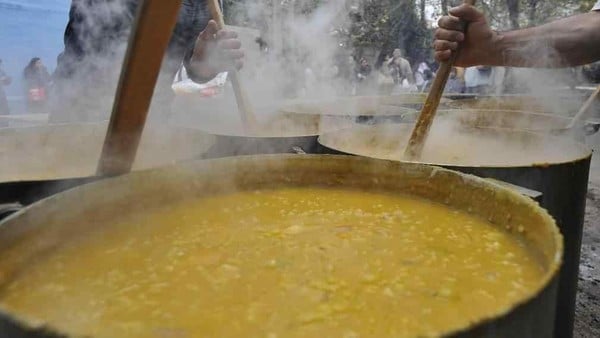Global Courant 2023-05-25 00:12:02
The May Revolution of 1810 is, by history and also by popular magnetism transmitted from generation to generation, an incomparable party in the ideology and celebration of all Argentines.
Perhaps because we have learned it for more than 200 years in family gatherings and in the seriousness of the classroom, the deed of May 25, 1810 in a rainy Buenos Aires has that I don’t know what…. Tradition, the smell of family, initiation, origin. But also inevitable flavors: the great traditional meals with which we celebrate those unforgettable days.
Here we tell you the 5 typical meals that are eaten in the commemoration of the May Revolution
May 25: the 5 typical meals eaten in commemoration of the May Revolution
National dishes were created throughout the country. Fires and stews with meat, corn, squash and different vegetables are baked throughout the country. Photo of a carbonade in the mountains.
Some of the recipes for our great national meals are of European origin. And it is understood: the inhabitants of what would later be Argentina were descendants of the ancient Spaniards who came to our lands. But just as certain as this culinary origin is the unique imprint of the products that grew here, in the humid pampas as well as in the vast north of what would soon be Argentina.
Here we tell you about those unique flavors that were born before the May Revolution and that accompany us every year on our National Holidays:
1. locro
May 25: the 5 typical meals eaten in commemoration of the May Revolution. El locro by Martín Molteni, a classic from Buenos Aires.
The popular meal that ended up entering the home of all social classes and is today, by definition, the great meal of national days. A thick, slow-cooked stew born from an ancient pre-Columbian dish based on white (or yellow) corn, beans and potatoes. The new settlers enriched it with red chorizo, ground chili pepper and paprika.
Each area of the country also added its typical products. “They made use of the elements of the earth, which is why the ingredients and forms of preparation varied depending on the region, although the main element was always corn,” Daniel Balmaceda describes in his book “Food in Argentine History.”
In that distant 1810, from very early the vendors settled in the Recova, an imposing building on Calle Defensa, a few meters from the Cabildo, with its large pots of locro bubbling over the fire.
2. Carbonada
May 25: the 5 typical meals eaten in commemoration of the May Revolution. Carbonada. In the colony it was served on the hollowed-out shell of the pumpkin due to the lack of tableware./ Photo Clarín.
Another wonderful dish of Belgian origin (“carbonadde”) that was eaten in the days of the May Revolution and remained as a dish of Argentine Creole food. Unavoidable in two central provinces such as Salta and Tucumán, our ancestors added to the taquitos of stewed meat, our popular corn, squashes, dried apricots, and raisins, and beer and mustard were removed from the original European recipe.
Although it has some similarities with the Spanish puchero, the carbonada is much thicker and was served in the hollowed-out shell of the pumpkin in colonial times, due to the lack of leftover crockery, something that gives it enormous uniqueness.
3. Tamales
May 25: the 5 typical meals eaten in commemoration of the May Revolution. Salta tamales, wonders for national celebrations.
A delicacy served today in any high-level Creole restaurant or restaurant throughout Argentina, it bears the imprint of pre-Hispanic America and is the most authentic and autochthonous food of this land.
Tamal is a word that comes from “tamalli” (means “wrapped” in the Nahuatl language) and the recipe of our ancestors is made up of a cooked corn dough combined with meat, vegetables and different seasonings that are more or less spicy to taste, such like chili or chili native to America.
Everything takes flight with delight when the filling is wrapped in the corn leaf itself (the popular chala), it is tied with strips made with thin cuts of the chala itself and it is placed in steamed pots until it is cooked.
4. Empanadas
May 25: the 5 typical meals eaten in commemoration of the May Revolution. Another classic that comes to us from colonial times: fried meat empanadas, with native seasonings./ Photo: Clarín.
The most popular dish of that rainy May 25, 1810, empanadas had an absolute consensus regarding the locro: the well-mannered ladies of the nascent Buenos Aires aristocracy ate them at street stalls after mass. Because empanadas were typical street products, like locro, but accepted by all.
It was also the most cosmopolitan food of the Creole taste. Born in Persia and later conquering Ancient Greece based on stacked dough, they arrived in the Middle East (many believe they came from there or China), where they are still known today as fatay.
They landed in Spain with the Muslim invasion of the eighth century and from there, incredibly tasty, the conquistadors brought them to the New World.
Our ancestors made them with wheat flour dough and pella fat. And in the filling, there was no doubt: meat cut with a knife, beef or lamb. But they also made chicken. In the north of Argentina they made them their own since the arrival of the ships and added an exceptional imprint according to the region.
The empanadas from Salta, the San Juan and the Tucumanas have been fighting for more than 200 years to convince the rest of the Argentines that theirs, with their own ingredients, are the best. Nothing better than a large plata with two of each: juicy and unforgettable.
5. Fried cupcakes
May 25: the 5 typical meals eaten in commemoration of the May Revolution. Fried sweet cakes were sold in street stalls on 25 May 1810./ Photo: Lucía Merle, Clarín.
The great candy of the inhabitants of Buenos Aires in the May Revolution of 1810, lasts to this day and invades all kinds of bakeries or confectioneries of the highest level on May 25. Dough jams stuffed with sweet potato or quince jelly.
The pastries of the colony were round, like a kind of bag made with the dough similar to empanadas, and fried in fat. Today’s are made of flour with water and fat, with 10 or 12 superimposed layers of puff pastry located in the shape of a star. But the spirit remains intact.








